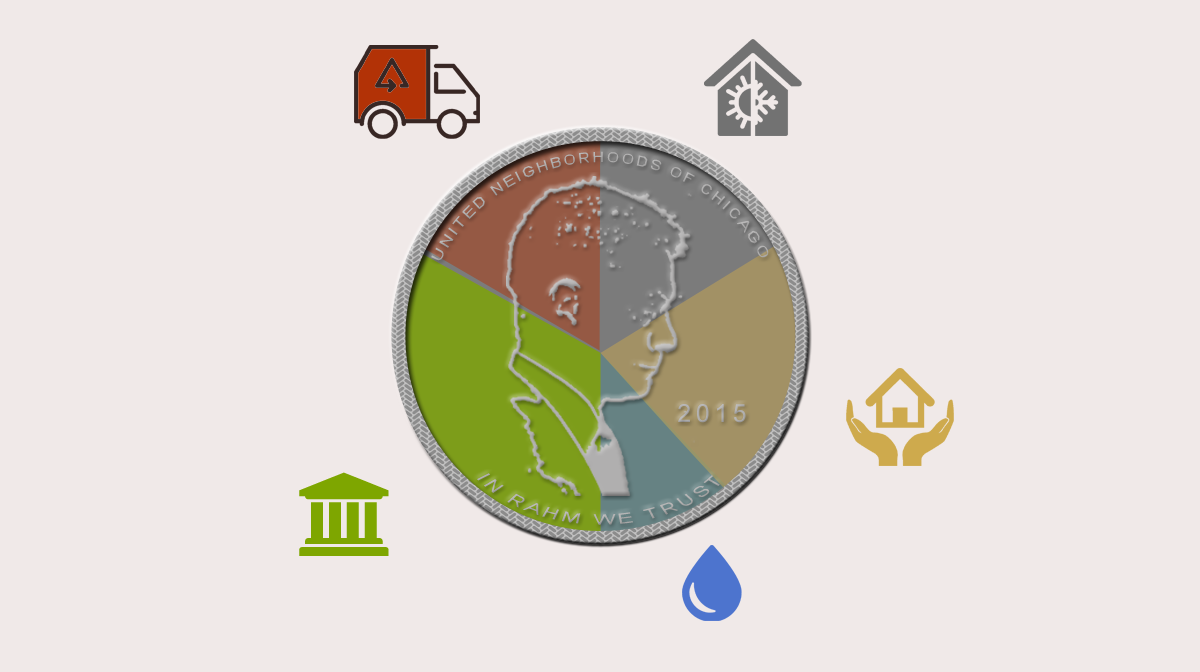We spend a lot of time talking about bad landlords here at RentConfident. After all, our business exists to protect tenants from the worst of the bunch. But we also do make a point to give credit when it's due for the Chicago landlords that are working hard and doing their best to stay afloat in the face of incredibly dense legislation and ever-rising costs.
As we head into tax season, those costs are a focal point for folks on both sides of the rental industry. With that in mind, today we'll be comparing the cost of being a homeowner vs being a landlord in Chicago by comparing the operating costs of two buildings sitting side by side. I'm not going to do an apples-to-apples comparison here. This is not about the difference between a single family home and a two-flat. This is more about the difference between housing as a personal thing and housing as a business.
Building #1 will be a single family home, owned and occupied by a family of four.
Building #2 will be a much larger apartment building. Of course, there are many different styles of apartment buildings, from tiny two-flats to enormous high rises. For the sake of keeping it real and something I can estimate, we'll focus on something very familiar to me - a vintage courtyard style apartment building with about 30 units. Like most buildings of this caliber, it has steam heat included in the rent, no air conditioning and no parking lot.
Let's choose a neighborhood that's not too upscale, not too troubled, with reasonably good schools and acceptable crime rates - a side street in Ravenswood will do nicely.
In order to obtain all the data I needed, I've had to base my numbers on a combination of a handful of properties in that area along with some usage statistics for things like water and gas costs. In both cases the buildings are fictional, but the numbers come from real research. I have done some rounding and adjusting for inflation, so if you're a homeowner, home buyer or landlord I would not suggest using these numbers for budgeting.
First let's compare the fixed costs - the ones that are pretty consistent every month.
Fixed Monthly Costs
| Single family home | 30 unit vintage courtyard building | |
|---|---|---|
| Sq ft | 1500 | 20000 |
| Lot size | 5000 Sq ft | 15000 sq ft |
| Population | 4 | 60 |
| 2014 Property Tax (monthly) | $791.67 | $2,916.67 |
| Water & Sewer (100 gal per person per day) | $91.44 | $1,371.60 |
| Mortgage Premium & Interest | $3,075.35 | $16,608.49 |
| Trash Pickup | $9.50 | $106.00 |
| Recycling Pickup | Included w. trash | $34.98 |
| Media Service | $100.00 | N/A |
| Power | $90.00 | $167.00 |
| Gas (Heat, Hot Water & Dryer(s)) | $150.00 | $1,750.00 |
| Insurance - Property and Liability | $250.00 | $625.00 |
| Insurance - Workman's comp (2 employees) | N/A | $8.50 |
| Insurance - Errors & Omissions | N/A | $25.00 |
| Insurance - Umbrella | N/A | $112.50 |
| Turnover Costs (see below) | N/A | $1,500.00 |
| Average Rent | N/A | $1,100.00 |
| Monthly Income | $33,000.00 | |
| Monthly Fixed Expenses | $4,557.96 | $25,225.74 |
| Net Income | $7,774.26 | |
About Those Turnover Costs...
In the table above I included a fixed line item of $1500/mo for turnover costs. This doesn't include rental commissions paid to agents, but rather includes all of the stuff that needs to be redone or replaced every time an apartment turns over:
- Paint
- Spackle
- Cleaning supplies
- Switchplate covers
- Light Bulbs
- Locks & Door Hardware
- Mini Blinds / Window treatments
- Toilet Seats
... Along with all of the things that need to be replaced every 2-3 times an apartment turns over:
- Light Fixtures
- Cabinets & Counters
- Bathroom sinks and Mirrors
- Shower heads
- Toilets
- Refrigerators
- Stoves
Seriously, tenants are much harder on stuff than homeowners would be. They also have certain expectations of apartment condition when they move into a new place, meaning that landlords have to frequently repair or replace damaged things like wobbly light fixtures and chipped sinks that homeowners might let slide for years.
Landlord-Exclusive and Variable Costs
"Great!" you say. "That landlord is walking away with nearly $8k/mo in profits!"
Hang on a minute. I did say that was just the fixed expenses. There's a whole bunch of other variable expenses for the landlord that I didn't include in that table. Everything else from here on down are expenses only incurred by landlords.
Fees & Licenses
When you own a big apartment building you're treated like a business. There's fees and fines that go along with this kind of status, including but not limited to:
- Occupancy or Zoning Compliance Certificate - required on sale or substantial renovation of some apartment buildings
- License to rent property - required in many suburbs but not in Chicago
- Fines for infractions - almost unavoidable in Chicago, especially tickets for overflowing dumpsters at month end.
- Bank Fees - at least 1 commercial account for operating expenses. Add another if you collect security deposits.
- Evictions - about $1000 each, including filing fees, process servers and sheriff service. Not including lost rent.
People
There's also a lot of people who help run a big 30 unit courtyard building. While I included workman's comp expenses for 2 employees on the building above, there's also a lot of other people that need to get paid for helping out a landlord. Some of these are optional, and some definitely not necessary for our sample building - a vintage Ravenswood courtyard - but all worth considering.
- Accountant - pretty much mandatory
- Attorney - also mandatory, not only for evictions but for drafting leases and other general advice.
- Leasing Agents - If you use outside agents, that's at least 1 month's rent plus fees every time an apartment turns over. If you have enough properties to keep your own leasing staff on payroll, the per-unit rental cost may go down but there's other concerns like advertising fees, increased Errors & Omissions insurance, real estate licenses and continuing education.
- Handymen & women - You get what you pay for. Note that leasing and handyman services can be folded into one building superintendent, at the cost of some efficiency and possibly one unit's worth of rent if they live on site. An experienced landlord will have a whole list of handymen at different price points and skill levels, from low-grade custodians to a top-notch renovators.
- Specialty repair (Heating & Cooling, Steam Boilers, Electricians & Plumbers) - must be licensed. These guys work at much higher hourly rates than your average handyman.
- Landscaping & Snow Removal - you can do this yourself, but Chicago requires both to be completed to a certain standard.
- Exterminators - some landlords make this a regular expense, others bring in spot treatment pest control as needed.
- Major project contractors - repairing and replacing roofs, windows, gutters, siding, tuckpointing, parking lots, fences, porches, etc.
- Door staff, Parking staff and Security Guards - Not required for our sample building but a luxury high rise building will have some or all of them.
Optional Add-ons
There's no end of service companies working to make a landlord's job easier, for a fee. Some include:
- Professional Property Management - about 10% of the gross monthly rent, plus an additional annual fee.
- Property Management Software - anywhere from free to thousands of dollars a month.
- Credit Card Processing Fees - for landlords who allow online payments and credit card payments.
- Laundry Maintenance - Collecting coins and servicing washers & dryers
You can see that once all of these additional unpredictable costs are added to the operating budget, you're going to eat through that extra $8000 in no time.
So what can you do? You can theoretically add on all kinds of luxuries, which will let you your asking prices. Of course, you can't raise the rent higher than the neighborhood incomes will support, so you don't want to go too far. At this point people simply will not pay $3000 to live in a vintage Ravenswood apartment no matter how much you gild the lily. Luxuries also require maintenance and regular replacement. Some of the luxuries that might be considered include:
- Dishwashers
- Microwaves
- Ceiling Fans
- Air Conditioners
- In-unit washers & dryers
- Roof decks
- Fitness centers
- Business centers
- Party rooms
But even if you don't include luxuries, you can see that it takes a very savvy business mind and a lot of balancing to run an apartment building in a decent way, even in a reasonably good neighborhood. It's easy to see why 30 unit buildings are the domain of mostly mid to large sized property management companies who can distribute labor and unpredictable costs across multiple properties. It's also easy to see why a landlord might want to cut corners - after all, they got into the business to make money.
So cheers to the good guys out there who are dealing with all of these costs. Next time you feel absolutely sure that your landlord is spending all your rent money on a riverboat in Indiana, take another look at this list and reconsider. Maybe.
RentConfident is a Chicago startup that provides renters with the in-depth information they need to choose safe apartments. Help us reach more renters! Like, Share and Retweet us!


